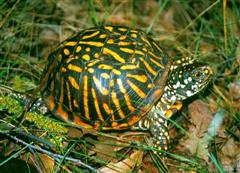Box Turtle - Ornate
Desert Ornate Box Turtle, Texas Ornate Box Turtle, Eastern Ornate Box Turtle Scientific Name: Terrapene ornata ornata
Sun, 6th July, 2025 - 3:04 am GMT
Sponsor Ads:

Alternative Name
Desert Ornate Box Turtle, Texas Ornate Box Turtle, Eastern Ornate Box Turtle Scientific Name: Terrapene ornata ornataBasic Info
The Ornate Box Turtle is a relatively small turtle, measuring only 4 to 6 inches in length. Their shells are dark brown with a yellow stripe and yellow lines down its back. They do not have teeth, but they use their sharp jaws to crush prey. The male can be differentiated from the female by their slightly concave plastron and red eyes (the female's eyes are brown). The baby turtles resemble the adults, only their stripes look like spots. The Ornate Box Turtle can live as long as 40 years, maybe longer.
Health
For housing, a glass aquarium is not a good idea for the Ornate Box Turtle. They will do well in an enclosed area outside, as long as the plants are wisely chosen. They also do well in a large indoor terrarium. For ground material, use peat-based potting compost and it is preferable to have it mixed with sphagnum moss. It should be at least three to four inches. Always be aware that they have plenty of shade and that the tank does not become too dry. They should have a tray of water in which they can soak and temperatures should remain in between 80 to 85 degrees Fahrenheit in the basking area and at 70 degrees Fahrenheit in a cooler area. Ornate Box Turtles are omnivores, eating a wide variety of fruits and vegetables such as grapes, berries, cantaloupe, bananas, yellow squash, and tomatoes to name a few. Breeding The Ornate Box Turtle mating can occur throughout the active season, but is generally most successful in late summer. They will reach sexual maturity between the ages of one and two years. The male will use his claw on his hind feet to hold the female in proper position. In June, female turtles will dig their nest holes, usually in sandy areas, lay two to eight eggs and then cover the nest. Eggs will incubate for about 55 to 70 days. Hatchlings are about nickel sized.Habitat
North AmericaBehavior
The Ornate Box Turtle possesses a high-domed shell (with special hinges on its plastron, or, lower shell, which hinge to completely box them in, hence the name) which acts as its defense from predators. Strictly a terrestrial species, when threatened, they will box themselves in. In the wild, they inhabit many environments and they make use of burrows and microclimates. They can be found all over the United States, but mostly, they seem to prefer areas where temperatures are higher and the soil is dryer. There are two subspecies of this turtle, Terrapene ornata ornata and Terrapene ornata luteola. T. o. ornata is also known as the Eastern Ornate Box Turtle and T. o. luteola is also known as the Texas or Desert Ornate Box Turtle. Ornate Box Turtles are very sensitive and they have many specialized needs, in terms of both environment and diet. In captivity, they are known to stress easily.Origin
North AmericaHistory
Among turtles bred as pets, they are one of the most difficult of North American species to maintain and they are definitely not recommended for beginners.Common Foods
Some will also eat pothos and cactus (spineless,of course), just to site a few examples. In addition live food such as crickets (with added calcium), waxworms, mealworms and earthworms, along with an occasional pinkie mouse are enjoyed.Sponsor Ads:
Television is chewing gum for the eyes. -- Unknown
Box Turtle - Ornate
Coded by: BGID® | ALL RIGHTS RESERVED Copyright © 2000-2025
Disclaimer | Privacy | Report Errors / Contact | Credits








 President of the United States of America - Real Estate mogul, Pageant owner and now one of the most controversial men in political history.
President of the United States of America - Real Estate mogul, Pageant owner and now one of the most controversial men in political history.  Global warming has been in and out as the "latest" hot topic for many years. It is, according to modern scientists, the result of man-made industrial pollutants, clearing forested areas, agriculture, etc. But now they are thinking it started way before the Industrial Revolution...
Global warming has been in and out as the "latest" hot topic for many years. It is, according to modern scientists, the result of man-made industrial pollutants, clearing forested areas, agriculture, etc. But now they are thinking it started way before the Industrial Revolution...  Politician, US Vice President and President of the USA - Joseph Robinette Biden Jr.
Politician, US Vice President and President of the USA - Joseph Robinette Biden Jr.  versus
versus  Russia: 'The Evil Empire'? Are they all that bad or is it just the USA trying to portray Russia as bad because they are a world power with land bigger and a society very different from the USA ideal?
Russia: 'The Evil Empire'? Are they all that bad or is it just the USA trying to portray Russia as bad because they are a world power with land bigger and a society very different from the USA ideal? 
 Corona virus
Corona virus 
 Users with wide screen monitors can benefit from more content on every page.
Users with wide screen monitors can benefit from more content on every page.